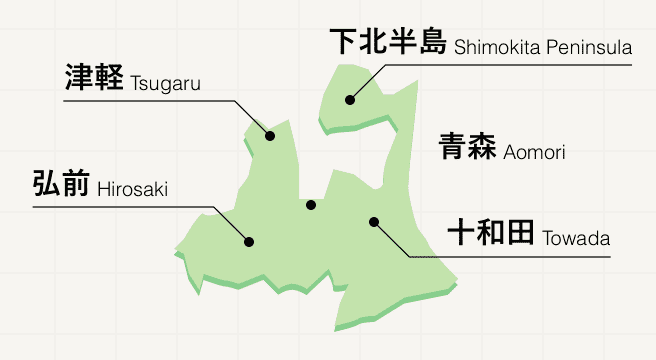Historical Monument Spots in Aomori Area
Area
-
-
Aomori
-
-
Aomori

Category


-
- Takahashi-ke Jutaku
-
4.04 Reviews
- Travel / Tourism
- Aomori Pref. Kuroishishi Nakamachi 38 Komi street
- This is the house of the Takahashi Family who were the official rice merchants of the Kuroishi Clan in the Edo feudal period. It is a historical building boasting more than 200 years of history since it was built between 1751 and 1763 and is designated as an Important Cultural Property. There is a coffee shop on site, and coffee and tea using water drawn from a well, as well as handmade sweets (anmitsu) are popular.
-
2月末の、吹雪が舞う平日。ひとりで弘前から弘南鉄道で黒石に行ってみました。 まず、高橋家住宅で温かいコーヒーでも、と思って行きましたら、冬は「冬眠中」だとか......。残念です。 古い家屋や町並みに、とても興味があるので楽しみにしていたのですが。次回は、暖かい季節に訪れて、雪辱を果たします^^
-
- Former Hirayama Family Residence
-
4.02 Reviews
- Travel / Tourism
- Aomori Goshogawara-shi Minato Chidori 144-1
- This cultural property is representative of Goshogawara City. The building was designated as an important cultural property in 1978. It is notable for its practically unaltered use of the scale and style of the upper class farm houses of the Tsugaru region, the fact that the rear bedrooms are separated, and the use of double joist beams and unique walls since it was reconstructed following an earthquake. It is an important artifact and one of only a small number of structures within the prefecture that can be definitively dated.
-
五能線五所川原駅から歩いて半時間、バスの五所川原営業所から歩いて十分という表示です。交通は不便な場所ですが、それだけに穴場と言えそうで宇。母屋の建坪だけで百十坪もあります。広い屋敷と、豪華な調度に目を奪われます。
-
- Former Iwata Family Residence
- Travel / Tourism
- Aomori Hirosaki-shi Wakadocho 31
- This is a building that is thought to have been built between the end of the Kansei period (1789-1801) and the Bunka period (around 1800). The primary structure component and roofs remain almost in the same condition as when it was built. Now it is restored to what it was at the time of the first modification based on a survey. It is a precious relic for knowing the life at that time in a residence of a middle-class samurai near the Hirosaki castle.
-
- Former Umeda Family Residence
- Travel / Tourism
- Aomori Hirosaki-shi Wakadocho 80
- This is one of the samurai residences in the Nakamachi area (nationally-designated important traditional architecture preservation district) that is open to the public. This is a section of town districts for samurai in order to protect pursuers on the north side of Hirosaki Castle, and it reminds us of the simple yet powerful life of a middle-class samurai in the late Edo period.
-
- Nanbu Toshiyasu Mausoleum
- Travel / Tourism
- Aomori Sannohe-gun Nanbucho Komukai Shiyo Kotobuki Temple 62-1
- Nanbu Toshinao, the 27th chieftain of the Nanbu clan, built this mausoleum for his fourth son Toshiyasu. The mausoleum was constructed with richly colored plated metal fixtures on the lacquering, and it is an important piece of cultural heritage that demonstrates one aspect of magnificent mausoleum construction in the Momoyama style that has been passed down in this region. It was designated a national important cultural asset in 1953.
-
- Joyato Lighthouse
- Travel / Tourism
- Aomori Kamikita-gun Nohejimachi Noheji 568
- This night lamp was built in 1827. Noheji Bay in Noheji Town was a prominent commercial port for southern feudal domains during the Hansei period that was crowded with many large ships, and it was established so they could safely come and go. It is said to be the oldest existing lamp in Japan, and it is now a symbol of the town.
-
- Former Hirosaki City Library
- Travel / Tourism
- Aomori Pref. Hirosakishi Shimoshiroganechou 2-1
- Built in 1906, this library was built in a Western style with a pair of Renaissance-esque octagonal steeples. Three stories tall and made of wood and mortar, the facility operated as a city library up to 1931; today it is open for viewing to the general public.
-
- Ishiba Family Residence
-
3.531 Reviews
- Travel / Tourism
- Aomori Pref. Hirosakishi Kamenokoumachi 88
- This residence is estimated to have been built in the middle of the Edo period, and is also designated as a National Important Cultural Property. For generations the household took the name “Seibei” and dealt in straw and household goods for the clan. Currently it is operating as a liquor store, and with the living room’s open hearth is an interesting building.
-
弘前城の亀甲橋向かいにある古民家です。説明書からですが、建築時は不明ですが、江戸中期の建物だそうです。国指定の重要文化財です。
-
- Kanagi Genkimura
- Travel / Tourism
- Aomori Goshogawara-shi Kanagicho Makita Kuwa Moto 39-2
-
- Kusunokiyoshikajutaku
- Travel / Tourism
- Aomori Pref. Goshogawarashi Motsukozawa Kakuregawa 695-4
-
- Former Sasamori Family's Residence
- Travel / Tourism
- Aomori Hirosaki-shi Wakadocho 72
Aomori Areas

Centuries-old stories of samurai at Kakunodate and the remains of millennia-old archaeological sites including the likes of Isedotai invite history buffs to delve into Aomori’s fascinating history. As the most northern prefecture on the Japanese mainland, Aomori enjoys a cooler climate, which makes it a welcome escape from the southern cities for combining castles, art galleries, and summer festivals with the great outdoors.
Best of Aomori
Search by Region
-
- Hokkaido / Tohoku
- Hokkaido
- Aomori
- Iwate
- Miyagi
- Akita
- Yamagata
- Fukushima
-
- Kanto
- Ibaraki
- Tochigi
- Gunma
- Saitama
- Chiba
- Tokyo
- Kanagawa
-
- Koshinetsu / Hokuriku
- Niigata
- Toyama
- Ishikawa
- Fukui
- Yamanashi
- Nagano
-
- Tokai
- Gifu
- Shizuoka
- Aichi
- Mie
-
- Kinki
- Shiga
- Kyoto
- Osaka
- Hyogo
- Nara
- Wakayama
-
- Chugoku
- Tottori
- Shimane
- Okayama
- Hiroshima
- Yamaguchi
-
- Shikoku
- Tokushima
- Kagawa
- Ehime
- Kochi
-
- Kyushu / Okinawa
- Fukuoka
- Saga
- Nagasaki
- Kumamoto
- Oita
- Miyazaki
- Kagoshima
- Okinawa






















